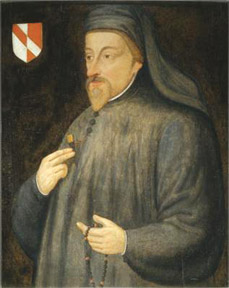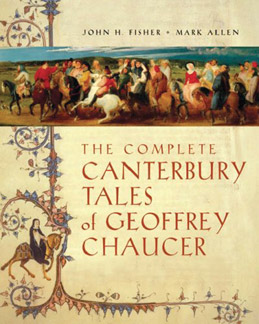|
Insights Into the Greats:
Chaucer, the Father of English Poetry
Priya David
Geoffrey Chaucer (1340-1400) is invariably referred to thus but,
whilst the appellation is entirely justified, it is appropriate to
explain why. Let this, therefore, determine our approach to this pioneer
of English poetry as we know it today.
 |
|
Geoffrey
Chaucer |
 Firstly, it was Chaucer who established English as the language of
England’s litera ry tradition. When he began writing, the thriving
literatures were those of France and Italy, with French entrenched as
the language of the English nobility and intelligentsia. Firstly, it was Chaucer who established English as the language of
England’s litera ry tradition. When he began writing, the thriving
literatures were those of France and Italy, with French entrenched as
the language of the English nobility and intelligentsia.
English was very much a provincial language, rather like Sinhala and
Tamil in days of yore. Chaucer, steeped as he was in Continental
literature, could have become a successful Anglo-French poet with an
international audience. Instead, he chose to write in his native
langauage, thereby changing for ever the direction that English
literature would take.
In doing so, Chaucer enriched English itself as the medium of
literary expression.
He incorporated in the language the elegance and refinement of
French, including some of its vocabulary, but retained the original
strength and vitality of native English speech.
He thereby rendered English more capable than French of expressing
the full range of poetic experience.The graceful vigour of his language
is evident in the famous opening lines of the “Prologue to the Cantebury
Tales”, reproduced here in the original Middle English with the modern
equivalent alongside:
Whan that Aprill with his shoures soote
When that April with his showers sweet
The droghte of March hath perced to the roote,
The drought of March has pierced to the root
And bathed every veyne in swich licour
And bathed every vein in such liquor
Of which vertue engendred is the flour;
Of which virtue engendered is the flower
If the metre, rhythm and rhyme (albeit not the spelling, word choices
and endings!) seem familiar to us, here is another of Chaucer’s
achievements, the establishment of a five-stress decasyllabic line
(precursor of the iambic pentametre) along with the rhyming couplet,
both of which would come to dominate English verse form.
Art of characterisation
The unfinished Cantebury Tales (a collection of stories told by a
party of pilgrims on their way to the Cantebury cathedral), together
with their Prologue (portraits of the pilgrims themselves), are
acclaimed as Chaucer’s greatest work. Fittingly, we find here more
evidence of the Chaucerian initiatives that have gone to the shaping of
English literature.
The art of characterisation, to be fully developed by novelists like
Dickens centuries after Chaucer, actually originates with the Prologue.
This is a marvel of character portrayal. Characters as diverse as a
gentle Knight, a flamboyant Squire, a mercenary Friar, an affected
Prioress and a hypocritical Pardoner are presented as individuals in
their own right as well as representatives of their type.Yet we cannot
fail to remark the universal nature of the human traits they exhibit..
Some portraits are so vivid in their detail that they have been compared
to the paintings of the Flemish “old masters” of the following century,
eg. the van Eyck brothers.
Here is an excerpt from the description of the Prioress:
And sikerly she was of greet disport,
And really she was quite fun-loving,
And ful plesaunt and amyable of port,
Very pleasant and amiable of disposition
And peyned hire to countrefete cheere
But she took pains to counterfeit an air
Of court, and to been estatlich of manere
Of the court, and to be stately in her manner And to ben holden digne
of reverence....
And to be reckoned worthy of reverence..... Ful semyly hir wympul
pynched was,
Very nicely was her wimple (head-dress) pinched,
Hir nose tretys, hir eyen greye as glas,
Her nose well-formed, her eyes grey as glass,
Hir mouth ful smal, and therto softe and reed;
Her mouth very small, and also soft and red;
But sikerly she hadde a fair forheed;
But certainly she had a pretty forehead;
It was almoost a spanne brood, I trowe;
It was of almost a span’s breadth, I believe;
For, hardily, she was nat undergrowe. For, certainly, she was not
poorly formed.
Of smal coral aboute hire arm she bar Made of small corals, on her
arm she wore
A peire of bedes, gauded al with grene,
A set of beads, all ornamented in green,
And thereon heng a brooch of gold ful sheene,
And thereon hung a brooch of gold very bright,
On which ther was first write a crowned A,
On which there was first written a crowned A,
And after Amor vincit omnia. And after that,
“Love conquers all.”
These few lines tell us that although Madam Eglentyne is by nature
amiable, she affects airs and demands respect. She is attractive and her
adornment is designed to emphasise her charms.
The broad exposure of her forehead is hardly in accord with the habit
of a nun. The legend on the brooch, in the circumstances, is equivocal!
Yet none of this is overtly stated. It is all suggested by acute
observation and subtle humour. This account is typical of Chaucer’s use
of ironic commentary in the Prologue and Tales. Irony is yet another of
the great stylistic devices he introduced to English literary
expression; a surely remarkable one when you consider the later
achievement of that master of ironic statement, Jane Austen.
Spectrum of humanity
By virtue of the Tales, moreover, Chaucer expanded literary style to
meet the multifarious demands of dramatic art. Just as the narrators of
the tales are drawn from all strata of society, their narrative styles
and diction too are reflective of their background and personalitiy.
(The genteel folk, for example, speak of young women as ladies whereas
the lower orders refer to them as wenches.) This ability to portray the
spectrum of humanity through living speech establishes Chaucer as the
founder of England’s great tradition of dramatic poetry, which was to
come to its full flowering with Shakespeare.
The reference to Shakespeare is opportune. The Bard of Avon is
venerated as the sacred font of creative writing in English. And, as far
as poetic expression rich in lexical, rhythmic and figurative complexity
is concerned, this is well deserved. However, as Regi Siriwardene has
pointed out in “The Pure Water of Poetry”, there is a simpler, barer
mode of poetic expression that, in eschewing such density, is equally -
if not more - effective. Shakespeare himself resorted to this in the
climactic moments of his greatest play, King Lear. Wordsworth was a
notable exponent.
And the Chaucerian phrase, “remarkable” ( in the words of Chaucer
scholar John Speirs) for its crystalline and limpid simplicity” (vide
the above quotations), may be regarded as the source of this “purer”
form of poetic expression.
Novel in verse
Notable earlier works by Chaucer were The Book of the Duchess, The
House of Fame, The Parliament of Fowls and Troilus and Criseyde..The
first three are in the allegorical style of mediaeval love poetry but
with topical subject matter. The last is like a novel in verse based on
the legend of this ill-fated pair of lovers.
It is Chaucer’s tribute to the mediaeval ideal of “courtly love”. of
which as CS Lewis famously remarked the “distinguishing marks (were)
humility, courtesy, adultery and the religion of love.” This
allegorical, fancifully and chivalrously romantic tradition that Chaucer
introduced to England culminated in Edmund Spenser’s 16th century poetic
epic, “The Faeire Queen”.
The Victorian critic, Matthew Arnold, said of Chaucer, “With him is
born our real poetry.” He adduced the exquisite diction and movement as
well as the broad and benign view of life that Chaucer brought into
English poetry.
Arnold, however, lamented that Chaucer’s poetry lacked the “high
seriousness” which he considered should be the hallmark of great poetry.
He meant the moral earnestness and implicit criticism of life that we
find in a poet like Shakespeare, whereby our own outlook is transformed.
This is not an entirely unfair criticism. We do not find in Chaucer,
for example, any of the “tragic realism” that the late MI Kuruvilla
would call to one’s attention in the work of the greatest writers.
Chaucer’s irony is never tragic, it is essentially comic. Yet, the
tolerant, shrewd but kindly view of life that Chaucer projects is not to
be belittled, particularly in these harshest of times.
And that TS Eliot’s maxim hereunder applies par excellence to
Geoffrey Chaucer and, accordingly, reconfirms him as the “father of
English poetry”, is indisputable:
“To pass on to posterity one’s own language, more highly developed,
more refined, and more precise than it was before one wrote it, that is
the highest possible achievement of the poet as poet.”
|



